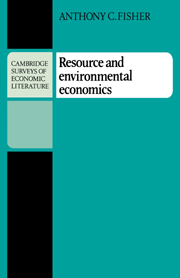Book contents
- Frontmatter
- Contents
- List of tables and figures
- Preface
- 1 Introduction
- 2 Exhaustible resources: the theory of optimal depletion
- 3 Renewable resources: the theory of optimal use
- 4 Resource scarcity: are resources limits to growth?
- 5 Natural resources and natural environments
- 6 Environmental pollution
- 7 Some concluding thoughts: the role of economics in the study of resource and environmental problems
- References
- Author index
- Subject index
5 - Natural resources and natural environments
Published online by Cambridge University Press: 07 October 2009
- Frontmatter
- Contents
- List of tables and figures
- Preface
- 1 Introduction
- 2 Exhaustible resources: the theory of optimal depletion
- 3 Renewable resources: the theory of optimal use
- 4 Resource scarcity: are resources limits to growth?
- 5 Natural resources and natural environments
- 6 Environmental pollution
- 7 Some concluding thoughts: the role of economics in the study of resource and environmental problems
- References
- Author index
- Subject index
Summary
Introduction: the transition from extractive to in situ resources
In the discussion of the theory of optimal depletion in Chapter 2 we noted (and formalized) two ideas from Mill (1848) that have a contemporary ring: (1) Extraction costs will increase as mineral deposits are depleted, owing to the need to sink shafts deeper, and so on. (2) The increase will be mitigated by discovery and technical change. Mill had another modern idea: that a stock of land was valuable not only for what could be extracted from it but also for the opportunities it provided for experiencing natural beauty and solitude.
Whether this had any influence on resource policy is not clear, but Mill's treatise had been through several editions by the time the national park system was established in the United States (1872), and preservation of natural beauty in wilderness environments was a minor goal of the early conservation movement (1890–1920). But the theme was not, to my knowledge, picked up by the economics profession until very much later. Instead, environmental disruption was first analyzed as a static externality, following the work of Pigou (1932) and his examples of sparks from railway engines, factory smoke, and the like. By the 1950s, several economists were developing elements of the modern theory of externalities, but in the process they were losing sight of Pigou's environmental examples.
- Type
- Chapter
- Information
- Resource and Environmental Economics , pp. 127 - 163Publisher: Cambridge University PressPrint publication year: 1981



